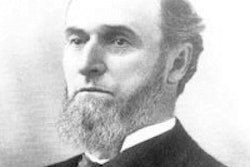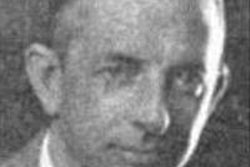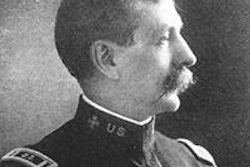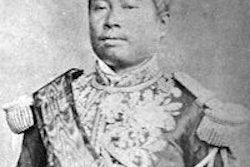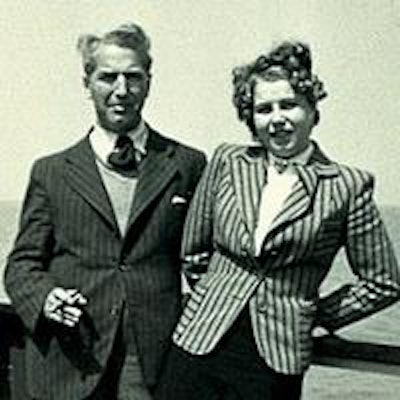
Anne Frank, the 13-year-old Jewish girl who was forced into hiding with her family in 1942 (while essentially a story of youthful optimism) lived and died in one of the saddest eras in all of history. Anne's diary memorialized the daily life of eight Jews confined like caged animals to a few rooms in second-story secret annex in a Dutch office building, which they inhabited for 25 terrifying months. Fate would be not kind to them. Just months before the war ended, a warehouseman betrayed them, and the Nazis deported them to concentration camps where all but one died, including Anne who would become the most famous victim of Adolf Hitler's Third Reich.
In October 1987, some 42 years after Anne's death, Joke Niesmeyer, an employee of Amsterdam's Anne Frank Foundation, found some of the household effects of Charlotte Kaletta at an Amsterdam flea market. The find consisted of a few books with Kaletta's name inscribed on the inside cover. Additionally, there was a small box of black and white photographs of a woman and an older man. As Niesmeyer looked at the pictures, she "suddenly saw a portrait of someone I recognized. It was [the dentist Dr. Fritz] Pfeffer, called 'Dussel' by Anne [Frank] in her diary."
Besides the books and photos, Niesmeyer found a "pack of yellowed newspaper clippings" -- all of them about Anne Frank and her diary. Recognizing the significance of her find, she asked the flea market stallholder if he had any other of Kaletta's effects. A week later, the stallholder produced two photograph albums, a pack of loose snapshots, four 1939 letters from Dr. Pfeffer to Kaletta, and the last letter he wrote to her in November 1942, when he went into hiding with seven other Jews.
When the Dutch historian Nanda van der Zee read newspaper accounts about the find, she was intrigued: "Because neither the portrait, nor letter of Fritz Pfeffer matched in any way the image of "Dussel" as described by Anne."
Dussel was the pseudonym given Dr. Pfeffer by Anne in her diary -- she used pseudonyms in her diary for all the inhabitants of the attic. In German, Dussel means fool. van der Zee notes that Anne describes Dr. Pfeffer in her diary as "an unfriendly, petty-minded, and irritating man," concluding "that the way Anne had portrayed 'Dussel' needed to be rectified."
van der Zee opined that she was "struck by the tragedy of a man [Pfeffer] in the shadow of a person well known like Anne Frank." Thereupon she embarked on a research project to learn what she could about the German dentist and authored her book, The Roommate of Anne Frank. In her own words, she wanted to know what kind of a person he was, "whether he hated, whether he loved, what [were] his weaknesses and his strengths." She wanted to understand the person who "like so many others, were exterminated as nobodies."
 Dr. Fritz Pfeffer and Charlotte Kaletta, 1939.
Dr. Fritz Pfeffer and Charlotte Kaletta, 1939.
Friedrich "Fritz" Pfeffer was born in Giessen, Germany, in 1889 as one of five children. He trained as a dentist and jaw surgeon, and was certified to practice in 1911. During World War I, he served in the German army. After the war, he married Vera Bythiner, with whom he had a son, Werner. Vera and Dr. Pfeffer divorced in 1932 with Fritz being awarded custody of Werner. In 1938, the rising tide of anti-Semitism that swept across Germany persuaded the Jewish dentist to "send [Werner] into the care of his brother Ernst [also a dentist]" who had previously immigrated to England.
Dr. Pfeffer and Kaletta met in 1936 when she visited him for dental work at his Berlin office. She was 26, nineteen years younger than the dentist. She was divorced and also had a son, Gustaf, who was in the custody of his father -- also a Jewish dentist. Dr. Pfeffer and Kaletta fell in love but were unable to marry due to the anti-Semitic Nuremberg Laws.
Adolf Hitler summed up the irrational Nazi hatred toward the Jews: "It is true that Jews are a race, but they are not human beings!" These laws forbade Jews from owning a bicycle, driving cars, or using public transportation. They could not attend theatres or cinemas or any other place of entertainment. Jews were barred from all public sporting facilities -- for example, public swimming pools, beaches, parks, or tennis courts. Jews could only shop between 3 p.m. and 5 p.m. and then only in "Jewish shops." Professionals -- doctors, lawyers, and dentists -- could only serve their fellow Jews. A curfew required all Jews to be off the streets by 8 p.m. Jews were forbidden to sit in their own garden or that of any friend after 8 p.m. and were required to wear a large yellow Star of David to identify themselves.
Dr. Pfeffer and Kaletta violated German law by living together -- he a Jew and she Aryan. In the era parlance, their cohabitation was considered a "racial disgrace." When Dr. Pfeffer was barred from practicing dentistry, he surreptitiously worked with a dental firm "where he moonlighted," according to van der Zee.
In November 1939, the couple fled to Holland, which was still a neutral country. Anne's father, Otto Frank, moved his family from Frankfurt, Germany, to Amsterdam in 1933 -- the year the Nazis took control of Germany. At the time of the move, Anne was 4 years old. In Amsterdam, the Franks, Dr. Pfeffer, and Kaletta became social acquaintances.
Even in Holland, they were barred by law from marrying -- the Dutch law, like the Nazi law, forbade "mixed" marriages. They contemplated going to Belgium, but as a mixed married couple would not be allowed to return to Holland. At one point, Dr. Pfeffer and Kaletta discussed moving to South America or Chile, but were thwarted by anti-Jewish immigration laws.
Contrary to Anne Frank's depiction of Pfeffer, research uncovered an active, athletic man who was a member of East Berlin's Undine Jewish rowing club.
As Germany enacted its Nuremberg Laws, originally designed to force German Jews out of Germany, virtually every nation enacted anti-Semitic immigration laws barring or limiting the number of Jews who were allowed to immigrate into their respective countries -- essentially closing their doors to German Jews desperate to escape the Nazis. Every Latin American nation, including Chile, put up immigration barriers against the Jews. Mexico, for example, allowed only 100 Jews per year to enter the country.
Contrary to Anne's depiction of Dr. Pfeffer, van der Zee's research uncovered an active, athletic man who was a member of East Berlin's Undine Jewish rowing club. A man with a "beautiful voice," which he used to lead friends and family during Jewish holiday celebrations. He was an accomplished horseman -- riding every week in Berlin -- and a loving, doting father to his son. An active outdoorsman, he enjoyed hiking in Germany's forests and mountains. He was an inquisitive traveler, soaking up the cultures of Italy, Greece, and England, which he visited. Many of the old photos depicted Dr. Pfeffer and Kaletta at various holiday destinations enjoying themselves.
When Germany overran Holland in May of 1940, the Nuremberg Laws were immediately adopted. As the Nazis tightened their grip on the Jews, Otto Frank had the foresight to begin preparation to hide his family in the unused upstairs annex and attic of his office building. They went into hiding in July 1942. Dr. Pfeffer joined them in November when Miep Gies, an employee of Otto, asked that he be included. Dr. Pfeffer was Gies' dentist. Gies would be one of the four "helpers" providing outside news and supplies during their confinement. She exchanged weekly letters between Dr. Pfeffer and Kaletta.
Anne had to share her bedroom with Dr. Pfeffer, which likely led to her animosity. John Blair, the producer of the 1995 Academy Award-winning documentary Remembering Anne Frank wrote about these love letters: "For this lonely man, shorn of his own family while ... sharing a bedroom with a difficult adolescent girl, this contact that Miep gave him with the outside world and with someone whom he loved and loved him, must have provided unimaginable support."
These love letters were immediately destroyed after being read -- for fear of what would happen if they fell into the hands of the Nazis. Besides the letters, Kaletta provided Dr. Pfeffer with money, toiletries, books, and his dental instruments, which he used to provide dental care to his seven fellow annex inhabitants.
On August 4, 1944, they were betrayed, arrested, and deported to concentration camps. Dr. Pfeffer was imprisoned at the Neuengamme concentration camp near Hamburg. He passed away on December 20, 1944, from enterocolitis, a fatal diarrheal disease, four and a half months after he was betrayed. He was 55. His other roommates -- Anne, her mother, and her sister also perished in Nazi concentration camps, as did Hermann and Auguste van Pels and their son Peter (known as the van Daan family in Anne's diary), and the other inhabitants of the annex. Only Anne's father survived.
Kaletta's ex-husband and only son, Gustaf, also perished in German concentration camps. Fritz's son, Werner, immigrated to the U.S. after the war and became a successful California businessman. Like Kaletta, he had little love for Anne Frank, the youthful diarist, who had portrayed his father in such unflattering terms.
In 1994, Jon Blair persuaded Werner to go with him to Amsterdam and visit the hiding place -- now a museum. There he was introduced to Miep Gies. The two had never met before. Blair describes one very sad scene when Werner "wiped away tears of embarrassed emotion" and an equally emotional Miep told him his father "was a lovely, lovely man ... and a very good dentist." Werner died two months later of cancer at the age of 64.
No one ever interviewed Kaletta, who married Fritz posthumously in 1950 -- retroactive to 1937. It allowed her to obtain a pension. She died in 1984 at age 74. One of Anne's entries in her diary reads: "He only thinks of his Lotte [Charlotte]," which speaks volumes of their love. van der Zee interposes a thought wondering, "Can you imagine what it means to see your loved one, your husband, who was so fond of children and everything that was young, being portrayed by a teenager like a moody and annoying idiot who is in her way?"
Daniel Demers is a semiretired businessman whose hobby is researching and writing about 19th and 20th century historical events and personalities. He holds a bachelor's degree in history from George Washington University and a master's degree in business from Chapman University. You can review his other published works at www.danieldemers.com.
Sources
Frank A. The Diary of a Young Girl. New York, NY: Bantam Books; 1993.
Johnson P. A History of the Jews. New York, NY: Harper & Rowe Publishers; 1987.
van der Zee N. Endlich C, trans. The Roommate of Anne Frank. Amsterdam, Netherlands: Lakeman Publishers; 1990.
Newspapers/journals
Verschuur P. Old letters shed new light on Anne Frank's roommate. Item. December 3, 1987:11c. Accessed February 13, 2014.
Websites
Anne Frank. Wikipedia website. https://en.wikipedia.org/wiki/Anne_Frank. Accessed February 13, 2014.
Anne Frank remembered, http://annefrankremembered.co.uk/miep_gies/. Accessed February 16, 2014.
Battle of the Netherlands. Wikipedia website. https://en.wikipedia.org/wiki/Battle_of_the_Netherlands. Accessed February 14, 2014.
Fritz Pfeffer. Wikipedia website. https://en.wikipedia.org/wiki/Fritz_Pfeffer. Accessed February 13, 2014.
Jon Blair. Wikipedia website. http://en.wikipedia.org/wiki/Jon_Blair. Accessed February 19, 2014.
The Nazification of Germany. https://fcit.usf.edu/holocaust/timeline/nazifica.htm. Accessed February 14, 2014.
Nuremberg Laws. Wikipedia website. https://en.wikipedia.org/wiki/Nuremberg_Laws. Accessed February 19, 2014.
Email correspondence
Erika Prins. Anne Frank House. February 19, 20, 2014.




